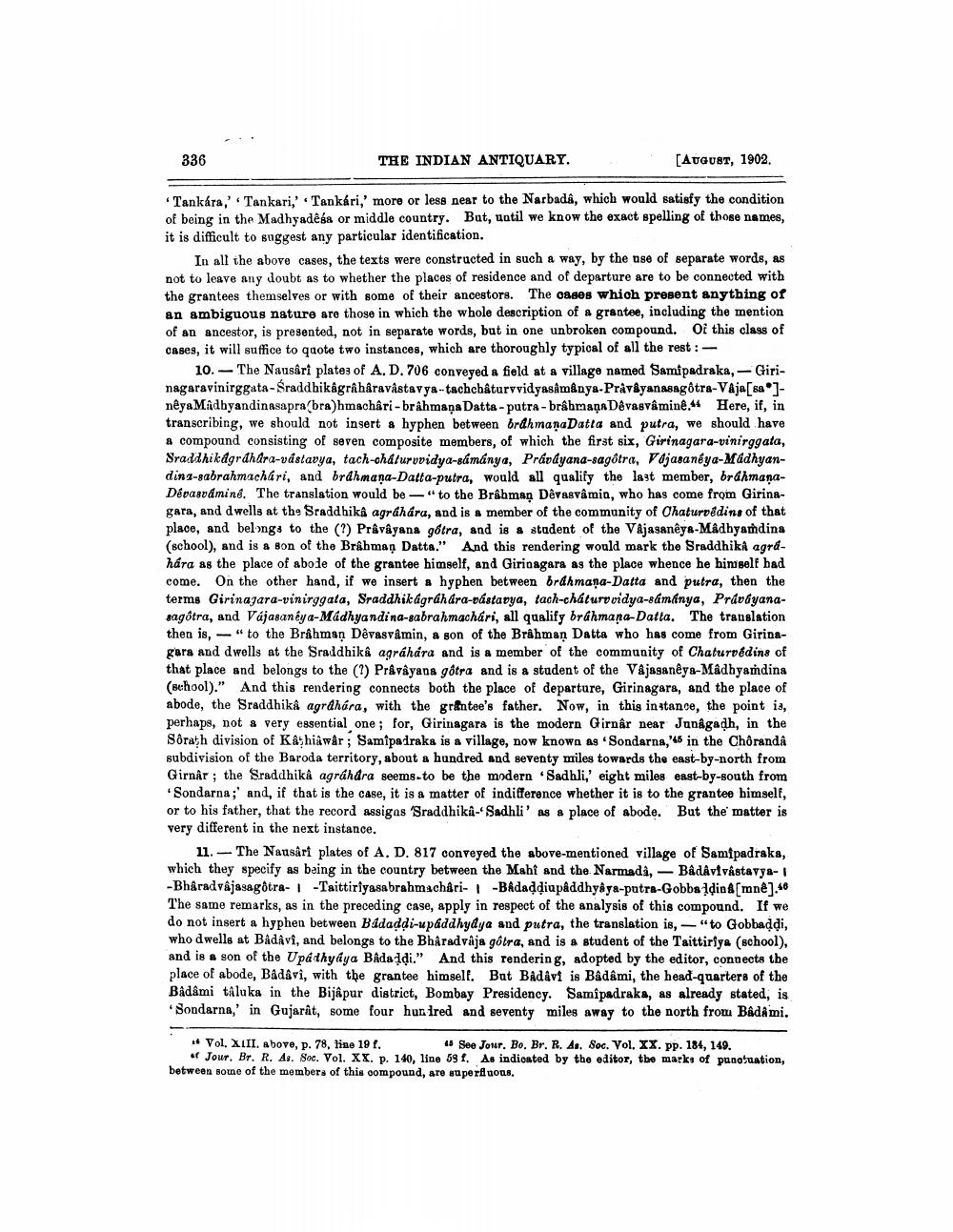________________
336
THE INDIAN ANTIQUARY.
.
[AUGUST, 1902.
* Tankára,'. Tankari,' Tankári,' more or less near to the Narbadâ, which would satisfy the condition of being in the Madhyadêba or middle country. Bat, until we know the exact spelling of those names, it is difficult to suggest any particular identification.
In all the above cases, the texts were constructed in such a way, by the use of separate words, as not to leave any doubt as to whether the places of residence and of departure are to be connected with the grantees themselves or with some of their ancestors. The cases which present anything of an ambiguous nature are those in which the whole description of a grantee, including the mention of an ancestor, is presented, not in separate words, but in one unbroken compound. Of this class of cases, it will suffice to quote two instances, which are thoroughly typical of all the rest :
10. - The Nausâri plates of A.D. 706 conveyed a field at a village named Samipadraka, - Girinagaravinirggata-Sraddhikågrå håravåstavya-tachcbâturvvidyasamânya-Pravậyanasagotra-Vája[sa]nêya Madhyandinasapra(bra)hmachâri - brahmaņa Datta-putra-brâhmaņa Dêvasvâmine. Here, if, in transcribing, we should not insert a hyphen between brahmanaDatta and putra, we should have a compound consisting of seven composite members, of which the first six, Girinagara-vinirggata, Sraddhikdgrdhara-vástavya, tach-chaturvvidya-sámánya, Pravdyana-sagotra, Vajasaneya-Madhyandina-sabrahmachari, and brdhmaņa-Datta-putra, would all qualify the last member, brahmanaDévasvamine. The translation would be -" to the Brahman Dêvasvâmia, who has come from Girinagara, and dwells at the Sraddhikâ agrahára, and is a member of the community of Chaturvédins of that place, and belongs to the (?) Prâvâyana gótra, and is a student of the Vâjasanêye-Madhyamdina (school), and is a son of the Brahman Datta." And this rendering would mark the Sraddhika agrahára as the place of abode of the grantee himself, and Girinagara as the place whence he himself had come. On the other hand, if we insert a hyphen between brdhmaņa-Datta and putra, then the terms Girinagara-vinirggata, Sraddhikagrahara-vástadya, tach-cháturtoidya-8ámánya, Pravdyanasagðtra, and Vájasaneya-Madhyandina-gabrahmachari, all qualify brahmana-Datta. The translation then is, -"to the Brahman Dêvasvâmin, a son of the Brâhman Datta who has come from Girinagara and dwells at the Sraddhika agráhara and is a member of the community of Chaturvédins of that place and belongs to the (?) Právâyana gôtra and is a student of the V&jaganêya-Madhyamdina (school)." And this rendering connects both the place of departure, Girinagara, and the place of abode, the Sraddhikâ agrahára, with the gr&ntee's father. Now, in this instance, the point is, perhaps, not a very essential one; for, Girinagara is the modern Girnar near Junagadh, in the Sôrath division of K & hiâwâr; Samipadraka is a village, now known as Sondarna,' in the Choranda subdivision of the Baroda territory, about a hundred and seventy miles towards the east-by-north from Girnar; the Sraddhikâ agráhdra seems to be the modern "Sadhli,' eight miles east-by-south from
Sondarna;' and, if that is the case, it is a matter of indifference whether it is to the grantee himself, or to his father, that the record assigas "Sraddhika--Sadhli' as a place of abode. But the matter is very different in the next instance.
11.- The Nausâri plates of A. D. 817 conveyed the above-mentioned village of Samipadraka, which they specify as being in the country between the Maht and the Narmada, Bå dåvivåstavya-1 -Bharadvajasagðtra- | -Taittiriyasabrahmachari- | -BAdaddiupaddhyâya-putra-Gobba Idio&[mne].46 The same remarks, as in the preceding case, apply in respect of the analysis of this compound. If we do not insert a hyphen between Bädaddi-upáddhydya and putra, the translation is, -"to Gobbaddi, who dwells at Badavi, and belongs to the Bhậradvaja gôtra, and is a student of the Taittiriya (school), and is a son of the Upadhyâya Båda idi." And this rendering, adopted by the editor, connects the place of abode, Badavi, with the grantee himself. But Badavi is Badêmi, the head-quarters of the Badâmi taluka in the Bijâpur district, Bombay Presidency. Samipadraka, as already stated, is * Sondarna,' in Gujarat, some four hundred and seventy miles away to the north from Bad mi.
# Vol. XIII, above, p. 78, line 19 f.
" See Jour. Bo. Br. R. As. Soc. Vol. XX. pp. 184, 149. * Jour. Br. R. As. Soc. Vol. XX. p. 140, line 59 1. As indioated by the editor, the marks of punofuation, between some of the members of this compound, are superfluous.




